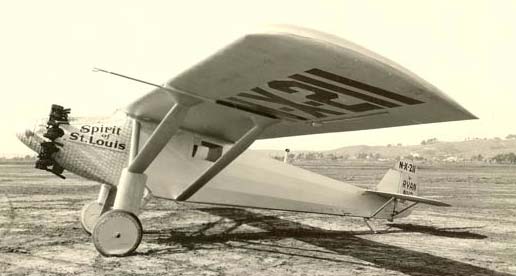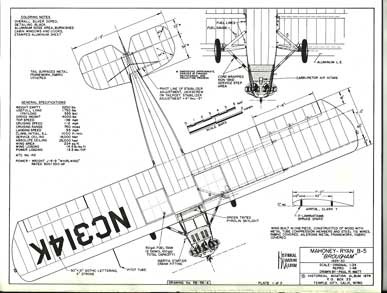Brougham Carriage:
Have you ever heard the name "Brougham"? In 19th-century London, broughams previously owned and used as private carriages were commonly sold off for use as hackney carriages, often displaying painted-over traces of the previous owner's coat of arms on the carriage doors. (from WIKI..) |
 |
The Ryan Brougham:
The Ryan Brougham was a small single-engine airliner produced in the United States in the late 1920s and early 1930s. Its design was reminiscent of the M-1 mailplane first produced by Ryan in 1926, and like it, was a high-wing, strut-braced monoplane of conventional design.
Design and development
Unlike the M-1, however, the Brougham had a fully enclosed cabin for the pilot and four passengers. The Brougham prototype was derived from the later M-2 and was powered by a 150 hp Hisso engine. Originally priced at $12,200, the price was reduced to $9,700 when fitted with a Wright J-5, and $5,750 with Hisso. One Brougham was fitted with floats. The only common parts between the famous Spirit of St. Louis and the first Ryan B-1s were the tail surfaces and a few of the wing fittings. Later B-1 Brougham production versions had no common parts.
The first production B-1 Brougham was ordered by a local hotel owner, but was delivered instead to well-known pilot Frank Hawks and was named "The Gold
Bug". Charles Lindbergh had come to the factory to examine that first B-1, but had instead ordered a completely new aircraft to his specifications. He used the Ryan NYP Spirit of St. Louis on his record-breaking transatlantic flight of 1927. Hawks renamed his B-1 "Spirit of San Diego" and flew to Washington with his wife to greet the triumphant Lindbergh. In the ensuing glare of publicity, Hawks was hired by the Ryan Aircraft company to be its official representative.
 |
 |
With the public idolizing Lindbergh, Hawks toured the country, selling rides in the aircraft "like Lindy flew." His Spirit was actually painted gold, but looked the part to the public. Another reason for the success of the Brougham was its performance at the 1927 National Air Races in Spokane, Washington where Hawks, who had obtained a contract with Maxwell House Coffee, with the now renamed "Miss Maxwell House" came in first for speed in the Detroit news Air Transport Speed and Efficiency Trophy Race. |
|
 |
Charles A. Lindbergh and the Ryan B-1X Brougham (NX4215) presented to him in 1928 by the manufacturer Mahoney Aircraft Corporation (formerly Ryan Airlines) after the "Spirit of St. Louis" had been retired. |
 |
| Hawks popularized the Brougham, which stimulated demand among small airlines and charter operators. The Brougham not only sold well in the domestic market, but was exported to China, Guatemala, Mexico and Salvador. Production peaked at 20 per month but was eventually halted by worsening economic conditions in the depression that led to the sale of the Ryan factory in October 1930. |
The 'Aotearoa':
 |
Lindbergh's successful trans-Atlantic flight led to a slightly modified Ryan Brougham being ordered for the first attempted trans-tasman flight between Australia and New Zealand. Named 'Aotearoa', the Māori name for New Zealand, and crewed by New Zealanders John Moncrieff and George Hood the aircraft left Richmond, near Sydney on the 10th of January 1928, on a flight expected to take about 14 hours. Radio signals were heard from the 'Aotearoa' for 12 hours before abruptly ceasing. The aviators failed to arrive in New Zealand, and no trace of them or their aircraft has ever been found. |
 The Ryan Brougham was an early float plane but using primitive floats |
 Glen's (the designer), Brougham beta card model on floats |
 The first Brougham was technically a renamed Bluebird Cabin plane which had just gone into production when Lindy walked in the door that fateful day in 1927. The NYP Special then became the new basis for an all new commercial planes called the Brougham, the first of which was the Gold Bug built for Frank Hawks right after the Lindbergh flight. Within a few weeks the B1 was the best selling plane in the US and this continued until the summer of 1928, when unsold planes began to pile up at San Diego. The company moved to St Louis and finally Detroit. The first Brougham was technically a renamed Bluebird Cabin plane which had just gone into production when Lindy walked in the door that fateful day in 1927. The NYP Special then became the new basis for an all new commercial planes called the Brougham, the first of which was the Gold Bug built for Frank Hawks right after the Lindbergh flight. Within a few weeks the B1 was the best selling plane in the US and this continued until the summer of 1928, when unsold planes began to pile up at San Diego. The company moved to St Louis and finally Detroit. |
General characteristics |
|
| Crew: One pilot | Wing area: 270 ft2 |
| Capacity: 4 passengers | Empty weight: 1,870 lb |
| Length: 27 ft 9 in | Gross weight: 3,300 lb |
| Wingspan: 42 ft 0 in | Powerplant: 1 × Wright J-5, 225 hp |
| Height: 8 ft 9 in | Maximum speed: 125 mph |
| Range: 700 miles | Service ceiling: 16,000 ft |
 |
 |
 |
 Modeln' Master, Bob Martin sends in these views of his Ryan Brougham. You can see how easily the Brougham kit can be worked into a great little RTC model |
 |
 |
| Click on the image to see enlarged version | |
++++


